
Cisticolas are a genus of very small insectivorous birds formerly classified in the Old World warbler family Sylviidae, but now usually considered to be in the separate family Cisticolidae, along with other southern warbler genera. They are believed to be quite closely related to the swallows and martins, the bulbuls and the white-eyes. The genus contains about 50 species, of which only two are not found in Africa: one in Madagascar and the other from Asia to Australasia. They are also sometimes called fantail-warblers due to their habit of conspicuously flicking their tails, or tailor-birds because of their nests.
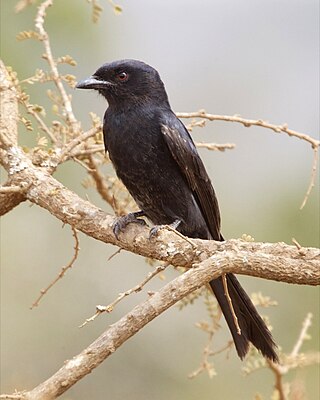
The fork-tailed drongo, also called the common drongo or African drongo, is a small bird found from the Sahel to South Africa that lives in wooded habitats, particularly woodlands and savannas. It is part of the family Dicruridae and has four recognized subspecies, D. a adsimilis, D. a. apivorus, D. a. fugax and D. a. jubaensis. Like other drongos, the fork-tailed is mostly insectivorous; its diet mainly consists of butterflies, termites, and grasshoppers.

The golden-headed cisticola, also known as the bright-capped cisticola, is a species of warbler in the family Cisticolidae, found in Australia and thirteen Asian countries. Growing to 9–11.5 cm (3.5–4.5 in) long, it is usually brown and cream in colour, but has a different appearance during the mating season, with a gold-coloured body and a much shorter tail. It is an omnivore and frequently makes a variety of vocalizations. Known as the "finest tailor of all birds", it constructs nests out of plants and spider threads. It mates in the rainy season. It has a very large range and population, which is thought to be increasing.

The blue-naped mousebird, also formerly called the blue-naped coly is a species of bird belonging to the family Coliidae within the order Coliiformes. They are the sister group to the clade Eucavitaves, which contains the families Leptosomiformes, Trogoniformes (trogons), Bucerotiformes, Piciformes and Coraciformes.

The neddicky, or piping cisticola, is a small passerine bird in the family Cisticolidae, which is native to Africa, southwards of the equator. Its strongholds are the light woodlands and shrublands of the subtropics and temperate regions of southern Africa. The common name, neddicky, is the Afrikaans name for the species.
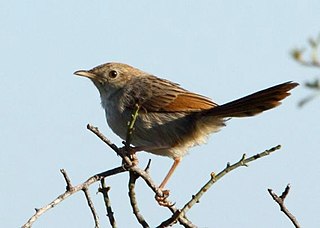
The grey-backed cisticola or red-headed cisticola is a small passerine bird. This cisticola is a resident breeder in southernmost Angola, Namibia and western South Africa.

Levaillant's cisticola, also known as the tinkling cisticola, is a small passerine bird which is native to marshlands in the uplands of Africa, southwards of the equator.

The Aberdare cisticola is a species of bird in the family Cisticolidae. It is endemic to Kenya.

The lazy cisticola is a species of bird in the family Cisticolidae. It is widespread throughout sub-Saharan Africa.
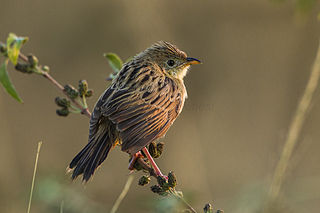
The wing-snapping cisticola, also known as Ayres' cisticola, is a species of bird in the family Cisticolidae. Its scientific name honours South African ornithologist Thomas Ayres.

The short-winged cisticola, also known as the siffling cisticola, is a species of bird in the family Cisticolidae. It is found in Angola, Benin, Burkina Faso, Burundi, Cameroon, Central African Republic, Chad, Republic of the Congo, Democratic Republic of the Congo, Ivory Coast, Eritrea, Ethiopia, Gabon, Gambia, Ghana, Guinea, Guinea-Bissau, Kenya, Liberia, Malawi, Mali, Mozambique, Niger, Nigeria, Rwanda, Senegal, Sierra Leone, Somalia, South Sudan, Tanzania, Togo, Uganda, Zambia, and Zimbabwe.
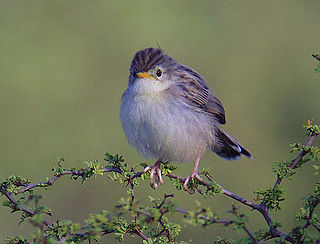
The Madagascar cisticola is a species of bird in the cisticola family (Cisticolidae). It inhabits areas to the west of the ˞Indian Ocean. It forms a superspecies with the closely related zitting cisticola and the Socotra cisticola.

The rattling cisticola is a species of bird in the family Cisticolidae which is native to Africa south of the equator, and parts of East Africa. It is a common to abundant species in open savanna and scrubland habitats, whether in arid, moist or upland regions. Especially during summer, it is highly conspicuous due to its strident and repetitive call-notes from prominent perches.
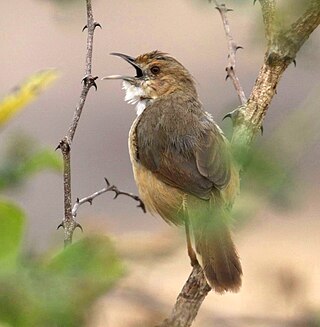
The red-faced cisticola is a species of bird in the family Cisticolidae. It is widely present across sub-Saharan Africa. Its natural habitats are subtropical or tropical seasonally wet or flooded lowland grassland and swamps.

The wailing cisticola is a species of bird in the family Cisticolidae. It is found in Angola, Eswatini, Lesotho, Malawi, Mozambique, South Africa, Tanzania, Zambia, and Zimbabwe. Its natural habitat is subtropical or tropical high-altitude grassland.

The whistling cisticola is a species of bird in the Cisticolidae family. It can be found in several regions within Africa, such as Angola, Benin, Burundi, Cameroon, Central African Republic, Republic of the Congo, Ivory Coast, Gabon, Gambia, Ghana, Guinea, Kenya, Liberia, Mali, Nigeria, Senegal, Sierra Leone, Sudan, Togo, Uganda, and Zambia. Its natural habitats include subtropical or tropical dry forests, dry savanna, and moist savanna.

The black-tailed cisticola is a species of bird in the family Cisticolidae found in Angola and Democratic Republic of the Congo. Its natural habitat is dry savanna and the canopy of smaller trees. It forages for insects both in the canopy and on the ground.

The buff-bellied warbler is a species of bird in the family Cisticolidae. It is monotypic within the genus Phyllolais. It is found in Cameroon, Central African Republic, Chad, Democratic Republic of the Congo, Eritrea, Ethiopia, Kenya, Nigeria, Rwanda, Sudan, Tanzania, and Uganda, where its natural habitats are subtropical or tropical dry forest, dry savanna, and subtropical or tropical dry shrubland.

The Mongolian ground jay or Henderson's ground jay, is a species of bird in the family Corvidae.
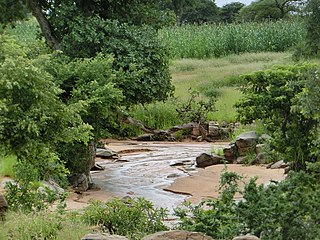
The wildlife of Sudan is composed of its flora and fauna. A variety of climate types in Sudan results in a wide range of habitats and the range of wildlife is diverse. Some 287 species of mammal have been recorded in the country and some 634 species of bird.





















